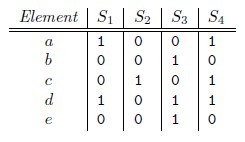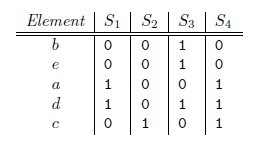Approximate Nearest Neighbors.接近最近邻搜索
有少量修改;如有疑问,请看链接原文.....
1.Survey:
Nearest neighbor search (NNS), also known as proximity search,similarity search orclosest point search,
is anoptimization problem for finding closest (or most similar) points. Closeness is typically expressed in terms of a dissimilarity
function: The less similar are the objects the larger are the function values. Formally, the nearest-neighbor (NN) search problem is defined as follows: given a setS of points in a spaceM and a query pointq ∈ M, find the
closest point inS toq. Donald Knuth in vol. 3 of The Art of Computer Programming (1973) called it thepost-office problem,
referring to an application of assigning to a residence the nearest post office. A direct generalization of this problem is ak-NN search, where we need to find thek closest points.寻找高维近邻点的最优化问题;
Most commonly M is a metric space and dissimilarity is expressed as a distance metric, which is symmetric and satisfies the triangle inequality. Even more common, M is taken to be the d-dimensionalvector space where dissimilarity is measured using theEuclidean
distance, Manhattan distance or other distance metric. However, the dissimilarity function can be arbitrary. One example are asymmetricBregman divergences, for which the
triangle inequality does not hold.[1]
距离矩阵的度量问题;
2.方法:(遇到的问题:维数灾难;)
Linear search(适合小范围的距离计算)
The simplest solution to the NNS problem is to compute the distance from the query point to every other point in the database, keeping track of the "best so far". This algorithm, sometimes referred
to as the naive approach, has a running time of O(Nd) where N is the cardinality of S and d is the dimensionality of M. There are no search data structures to maintain, so linear search has no space complexity beyond the storage of the database. Naive search can, on average, outperform space partitioning
approaches on higher dimensional spaces.[2]
Space partitioning(决策树?)
Since the 1970s, branch and bound methodology has been applied to the problem. In the case of Euclidean space this approach is known asspatial
index or spatial access methods. Several space-partitioning methods have been developed for solving the NNS problem. Perhaps the simplest is thek-d tree, which iteratively bisects the search space
into two regions containing half of the points of the parent region. Queries are performed via traversal of the tree from the root to a leaf by evaluating the query point at each split. Depending on the distance specified in the query, neighboring branches
that might contain hits may also need to be evaluated. For constant dimension query time, average complexity isO(log N)[3]
in the case of randomly distributed points, worst case complexity analyses have been performed.[4]
Alternatively theR-tree data structure was designed to support nearest neighbor search in dynamic context, as it has efficient algorithms for insertions and deletions.
In case of general metric space branch and bound approach is known under the name ofmetric
trees. Particular examples include vp-tree and BK-tree.
Using a set of points taken from a 3-dimensional space and put into aBSP
tree, and given a query point taken from the same space, a possible solution to the problem of finding the nearest point-cloud point to the query point is given in the following description of an algorithm. (Strictly speaking, no such point may exist,
because it may not be unique. But in practice, usually we only care about finding any one of the subset of all point-cloud points that exist at the shortest distance to a given query point.) The idea is, for each branching of the tree, guess that the closest
point in the cloud resides in the half-space containing the query point. This may not be the case, but it is a good heuristic. After having recursively gone through all the trouble of solving the problem for the guessed half-space, now compare the distance
returned by this result with the shortest distance from the query point to the partitioning plane. This latter distance is that between the query point and the closest possible point that could exist in the half-space not searched. If this distance is greater
than that returned in the earlier result, then clearly there is no need to search the other half-space. If there is such a need, then you must go through the trouble of solving the problem for the other half space, and then compare its result to the former
result, and then return the proper result. The performance of this algorithm is nearer to logarithmic time than linear time when the query point is near the cloud, because as the distance between the query point and the closest point-cloud point nears zero,
the algorithm needs only perform a look-up using the query point as a key to get the correct result.
空间划分是一个构建空间树的过程,其构建过程比较复杂,涉及到大量的计算;
Locality sensitive hashing(hash过程,可以近似O(1)的时间查询表)
Locality sensitive hashing (LSH) is a technique
for grouping points in space into 'buckets' based on some distance metric operating on the points. Points that are close to each other under the chosen metric are mapped to the same bucket with high probability.[5]
Nearest neighbor search in spaces with small intrinsicdimension
The cover tree has a theoretical bound that is based on the dataset's doubling constant. The bound on search time is O(c12 log n) wherec is theexpansion
constant of the dataset.
Vector approximation files
In high dimensional spaces, tree indexing structures become useless because an increasing percentage of the nodes need to be examined anyway. To speed up linear search, a compressed version of the
feature vectors stored in RAM is used to prefilter the datasets in a first run. The final candidates are determined in a second stage using the uncompressed data from the disk for distance calculation.[6]
Compression/clustering based search
The VA-file approach is a special case of a compression based search, where each feature component is compressed uniformly and independently. The optimal compression technique in multidimensional
spaces is Vector Quantization (VQ), implemented through clustering. The database is clustered and the most "promising" clusters are retrieved. Huge gains over VA-File, tree-based indexes and sequential scan have been observed.[7][8]
Also note the parallels between clustering and LSH.
3.次优最近邻
Algorithms that support the approximate nearest neighbor search includelocality-sensitive
hashing,best bin first andbalanced
box-decomposition tree based search.[9]
(1):ε-approximate nearest neighbor search is a special case of thenearest neighbor search problem. The solution
to the ε-approximate nearest neighbor search is a point or multiple points within distance (1+ε) R from a query point, where R is the distance between the query point and its true nearest neighbor.
Reasons to approximate nearest neighbor search include the space and time costs of exact solutions in high dimensional spaces (seecurse
of dimensionality) and that in some domains, finding an approximate nearest neighbor is an acceptable solution.
Approaches for solving
ε-approximate nearest neighbor search includekd-trees,Locality
Sensitive Hashing andbrute force search.
(2):
Best bin first is a
search algorithm that is designed to efficiently find an approximate solution to the
nearest neighbor search problem in very-high-dimensional spaces. The algorithm is based on a variant of thekd-tree
search algorithm which makes indexing higher dimensional spaces possible. Best bin first is an approximate algorithm which returns the nearest neighbor for a large fraction of queries and a very close neighbor otherwise.[1]
Differences from kd tree:
- Backtracking is according to a priority queue based on closeness.
- Search a fixed number of nearest candidates and stop.
- A speedup of two orders of magnitude is typical. 主要是对于超大型数据库进行相似性查询;
References:Beis, J.; Lowe, D. G. (1997). "Shape indexing
using approximate nearest-neighbour search in high-dimensional spaces". Conference on Computer Vision and Pattern Recognition. Puerto Rico. pp. 1000–1006.CiteSeerX:10.1.1.23.9493.
(3):LSH:http://en.wikipedia.org/wiki/Locality_sensitive_hashing
Locality-sensitive hashing (LSH) is a method of performing probabilisticdimension reduction
of high-dimensional data. The basic idea is tohash the input items so that similar items are mapped to the same buckets with
high probability (the number of buckets being much smaller than the universe of possible input items). This is different from the conventional hash functions, such as those used incryptography,
as in the LSH case the goal is to maximize probability of "collision" of similar items rather than avoid collisions.[1]
Note how locality-sensitive hashing, in many ways, mirrors data clustering andNearest neighbor search.
(二):局部敏感hash:
(三):minihash:原文链接:http://my.oschina.net/pathenon/blog/65210
转自wiki:http://en.wikipedia.org/wiki/Locality_sensitive_hashing
1.概述introduction:
Broder提出,最初用于在搜索引擎中检测重复网页。它也可以应用于大规模聚类问题。
Jaccard index是用来计算相似性,也就是距离的一种度量标准。假如有集合A、B,那么,

假定h是一个将A和B中的元素映射到一些不相交整数的哈希函数,而且针对给定的S,定义hmin(S)为S集合中具有最小h(x)函数值的元素x。这样,只有当最小哈希值的并集A
∪ B依赖于交集A ∩B时,有hmin(A) =hmin(B)。 因此,
- Pr[hmin(A) =hmin(B)] =J(A,B).
另一方面来说,如果r是一个当hmin(A) =hmin(B)时值为1,其它情况下值为0的随机变量,那么r可认为是J(A,B)的无偏估计。尽管此时方差过高,单独使用时没什么用处。最小哈希方法的思想是通过平均用同一方式构造的许多随机变量,从而减少方差。
那么对集合A、B,hmin(A) = hmin(B)成立的条件是A ∪ B 中具有最小哈希值的元素也在 ∩ B中。这里有一个假设,h(x)是一个良好的哈希函数,它具有很好的均匀性,能够把不同元素映射成不同的整数。
所以有,Pr[hmin(A)
= hmin(B)] = J(A,B),即集合A和B的相似度为集合A、B经过hash后最小哈希值相等的概率。
第一种:使用多个hash函数
/ |Min(A)k ∪ Min(B)k|,及Min(A)k和Min(B)k中相同元素个数与总的元素个数的比例。

beadc,那么对应的矩阵为

h(S1) = a,同样可以得到h(S2) = c, h(S3) = b, h(S4) = a。
(3):^Chum,
Ond?ej; Philbin, James; Isard, Michael; Zisserman, Andrew, Scalable near identical image and shot detection, Proceedings of the 6th ACM International Conference on Image and Cideo Retrieval (CIVR'07). 2007,doi:10.1145/1282280.1282359;Chum,
Ond?ej; Philbin, James; Zisserman, Andrew,Near duplicate image detection: min-hash and tf-idf weighting, Proceedings of the British
Machine Vision Conference,
Approximate Nearest Neighbors.接近最近邻搜索的更多相关文章
- 快速近似最近邻搜索库 FLANN - Fast Library for Approximate Nearest Neighbors
What is FLANN? FLANN is a library for performing fast approximate nearest neighbor searches in high ...
- sklearn:最近邻搜索sklearn.neighbors
http://blog.csdn.net/pipisorry/article/details/53156836 ball tree k-d tree也有问题[最近邻查找算法kd-tree].矩形并不是 ...
- ann搜索算法(Approximate Nearest Neighbor)
ANN的方法分为三大类:基于树的方法.哈希方法.矢量量化方法.brute-force搜索的方式是在全空间进行搜索,为了加快查找的速度,几乎所有的ANN方法都是通过对全空间分割,将其分割成很多小的子空间 ...
- Searching for Approximate Nearest Neighbours
Searching for Approximate Nearest Neighbours Nearest neighbour search is a common task: given a quer ...
- [机器学习系列] k-近邻算法(K–nearest neighbors)
C++ with Machine Learning -K–nearest neighbors 我本想写C++与人工智能,但是转念一想,人工智能范围太大了,我根本介绍不完也没能力介绍完,所以还是取了他的 ...
- 统计学习方法——KD树最近邻搜索
李航老师书上的的算法说明没怎么看懂,看了网上的博客,悟出一套循环(建立好KD树以后的最近邻搜索),我想应该是这样的(例子是李航<统计学习算法>第三章56页:例3.3): 步骤 结点查询标记 ...
- 【cs231n】图像分类-Nearest Neighbor Classifier(最近邻分类器)【python3实现】
[学习自CS231n课程] 转载请注明出处:http://www.cnblogs.com/GraceSkyer/p/8735908.html 图像分类: 一张图像的表示:长度.宽度.通道(3个颜色通道 ...
- 基于KD-Tree的最近邻搜索
目标:查询目标点附近的10个最近邻邻居. load fisheriris x = meas(:,:); figure(); g1=gscatter(x(:,),x(:,),species); %spe ...
- 【POJ】2329 Nearest number - 2(搜索)
题目 传送门:QWQ 分析 在dp分类里做的,然而并不会$ O(n^3) $ 的$ dp $,怒写一发搜索. 看起来是$ O(n^4) $,但仔细分析了一下好像还挺靠谱的? poj挂了,没在poj交, ...
随机推荐
- Tost元素识别
在日常使用App过程中,经常会看到App界面有一些弹窗提示(如下图所示)这些提示元素出现后等待3秒左右就会自动消失,那么我们该如何获取这些元素文字内容呢? Toast简介 Android中的Toast ...
- 深度遍历DFS---树
一.二叉树的深度 题目: 给定一个二叉树,找出其最大深度. 二叉树的深度为根节点到最远叶子节点的最长路径上的节点数. 说明: 叶子节点是指没有子节点的节点. 示例: 给定二叉树 [3,9,20,nul ...
- 【深度学习框架】使用PyTorch进行数据处理
在深度学习中,数据的处理对于神经网络的训练来说十分重要,良好的数据(包括图像.文本.语音等)处理不仅可以加速模型的训练,同时也直接关系到模型的效果.本文以处理图像数据为例,记录一些使用PyTorc ...
- kissui.scrollanim页面滚动动画库插件
简介 kissui.scrollanim是一款实用的纯JS和CSS3页面滚动动画库插件.通过该插件可以使元素进入浏览器视口的时候,展示指定的CSS3动画效果. 下载地址及演示 在线演示 在线下载 安装 ...
- python 实现kmeans聚类
编程中在做数值相等判断的时候,直接使用==判断并不可靠.实际上经过运算后的两个值(浮点型)并不可能完全一致,可能会因为小数点后的些许差异导致判断为false. 比如: 1 print 1e-5 == ...
- js借助JSONP实现百度搜索框提示效果
主要借助百度搜索的API,调用时会存在跨域问题,需要通过JSONP来解决这个问题,代码如下(代码中部分使用ES6语法): HTML <input type="text" id ...
- 暑假集训D14总结
%dalao 今天dalao继续来讲课~讲的是一个叫kd树的奇怪东西= = 然而啥都没听懂 考试 今天多校联考,日常炸= = 照例打了前两道题的暴力(T1随便hash一下就水过了啊喂),然后开始推T3 ...
- codeforces 257c
#include<stdio.h> int main() { __int64 n,m,k,i,j,a,b; while(scanf("%I64d%I64d%I64d", ...
- python清除数据库错误日志
# coding=gbk from encodings import gbk import re import sys import os import pyodbc import trac ...
- JAVA进阶-泛型
>泛型:泛型指代了參数的类型化类型,一般被用在接口.类.方法中 >作用:用来确定參数的范围,在书写代码的时候提前检查代码的错误性 >泛型的声明,下面给出类声明,依此类推: class ...
